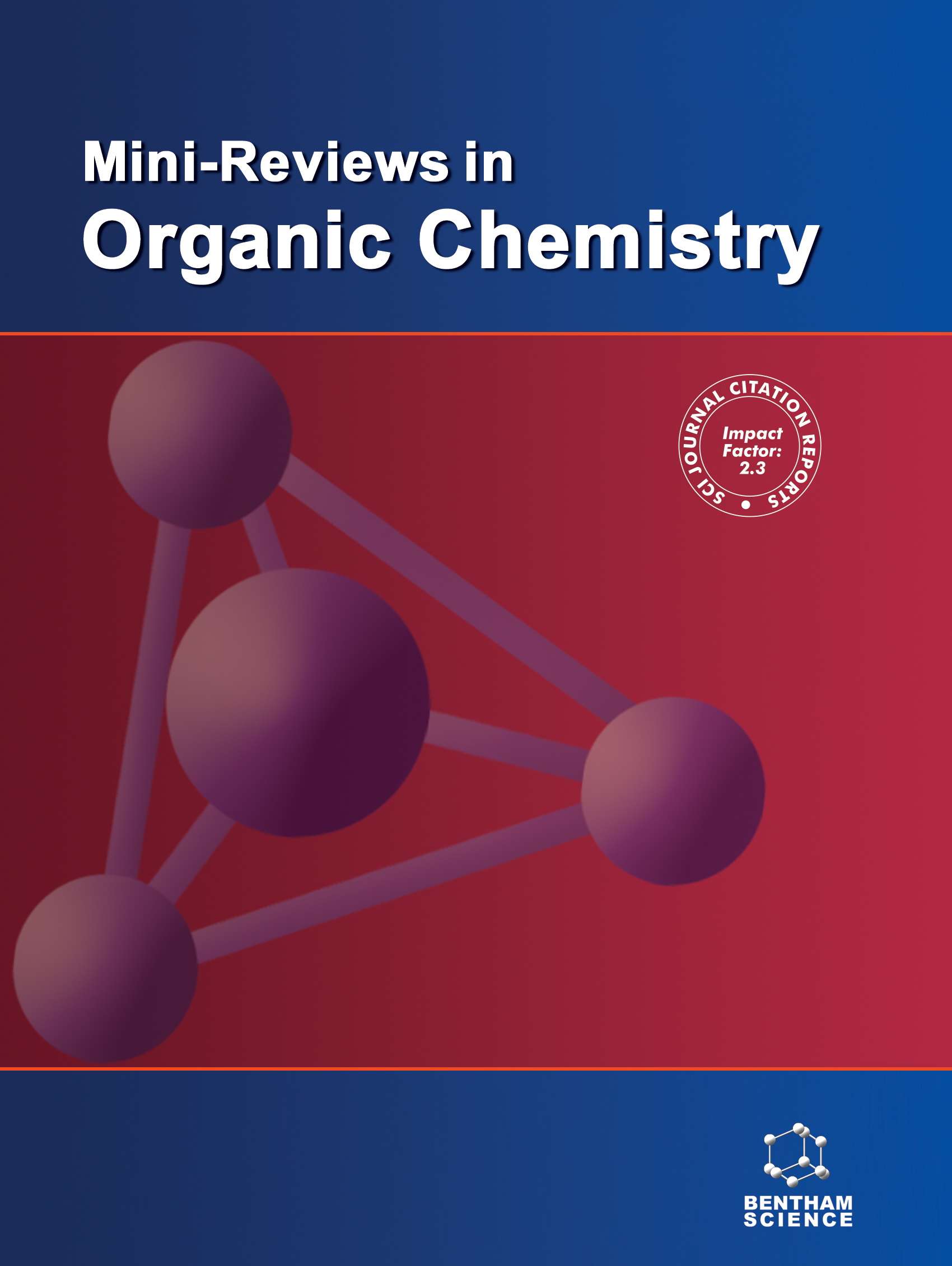Mini-Reviews in Organic Chemistry - Volume 4, Issue 3, 2007
Volume 4, Issue 3, 2007
-
-
Selected Recent Developments in the Enantioselective Reduction of Imines by Asymmetric Transfer Hydrogenation
More LessAuthors: Piotr Roszkowski and Zbigniew CzarnockiThe asymmetric transfer hydrogenation is a highly versatile tool for the stereoselective reduction of C=O and C=N prochiral groups. Carbonyl compounds have been the most frequently used as the synthetic substrates but imines were much less popular despite their importance as the sources of chiral amines. This review summarizes recent development in a search for more effective ligands and conditions of the reduction procedure. Particularly useful appear the mono-tosylated 1,2-diamines as the chirality inductors in the presence of a mixture of formic acid and triethylamine as a hydrogen source. Also, the structure of the substrates plays very important role. The cyclic endogenous imines usually give highest optical yield of the products.
-
-
-
Synthesis of Carbasugars Based on Ring Closing Metathesis: 2000-2006
More LessAuthors: Joaquin Plumet, Ana M. Gomez and J. Cristobal LopezCarbasugars (a term coined for the carbocyclic analogues of carbohydrates) play a prominent role within the broad field of carbohydrate mimetics. Natural carbasugars, either as single molecules or as subunits of more complex molecules, have shown to display interesting biological activities. On the other hand, synthetic carbasugars have also shown similar biological activities. Normally, the construction of the carbocyclic framework is regarded as the key step in the synthesis of carbasugars. In this context, the use of ring closing metathesis (RCM) has proven to be of great value in recent synthetic approaches to carbasugars, owing to the discovery of easy to handle, robust, well defined, recyclable catalysts compatible with multiple functionalities. In this manuscript, we have focused on synthetic approaches to carbasugars and more complex derivatives that illustrate the usefulness of RCM reactions in the preparation of carbocyclic frameworks from sugar dienes.
-
-
-
Recent Examples of Divergent Catalysis in Organic Reactions: Unexpected Findings or Rational Design?
More LessAuthors: Li-Wen Xu, Li Li and Guo-Qiao LaiThe term ‘divergent catalysis’ describes different catalytic chemical reactions that occur with the same substrates (reactants) under controllable conditions, especially using different catalysts. Various substrates were found to work with versatile reactivity under different catalytic conditions, resulting in the formation of different products. However, the examples of rationally designed divergent catalysis are still few. This review is focused on the achievements of divergent catalysis with the simplest substrates in the past decades. It includes divergent catalysis of one-component and two-component reactions with the same and simple reagents, ranging from carbon-carbon-forming pinacol coupling, benzoin condensation, Ullmann coupling, C-H homocoupling or activation, ring-closing metathesis, cyclization, Stetter reaction, Baylis-Hillman reaction, Friedel-Crafts reaction, C-H Heck coupling, 1,2-additon reaction and Michael addition, to the carbon-heteroatom bond-forming C-N cross coupling, hydroamination reaction, aza-Michael reaction, C-H oxidative amination, acetalization, and esterification.
-
-
-
β-Cyclodextrin as a Catalyst in Organic Synthesis
More LessThis mini-review outlines recent (until the end of 2006) key developments in the use of β-cyclodextrin as a catalyst in organic synthesis. β-cyclodextrin is a water soluble supramolecular catalyst especially useful for transformations such as oxirane ring-opening, aziridine oxidation of alcohols, hydrolysis of phosphate esters and amidation of acids. It has been used for the selective synthesis of 2,6- naphthalene dicarboxylic acid, introduction of protecting groups and for ester cleavage. Interestingly, it has also been used in the aza- Michael addition of amines to conjugated alkenes, in photo-Reimer-Tiemann reactions and as a phase transfer catalyst.
-
-
-
Two-Phase Systems with Solidified Water Phases - Tools for Technical Use of Sensitive Catalysts
More LessAqueous-organic two-phase systems are important tools in organic synthesis to enable reactions that employ compounds with incompatible solubilities. For technical application, different strategies have been developed to prevent coalescence without vast energy input and deactivation of sensitive compounds. A particularly promising one is the solidification of the aqueous phase by forming small distinguished compartments with polymers. The respective systems are assessed with special emphasis on the utility for enzyme catalysed synthesis in organic solvents.
-
-
-
Siderotyping of Fluorescent Pseudomonads - Problems in the Determination of Molecular Masses by Mass Spectrometry
More LessAuthors: H. Budzikiewicz, M. Schafer and J.-M. MeyerSpecies and even subspecies of fluorescent members of the Pseudomonadaceae can be identified by determining the nature of their main siderophores (iron chelating metabolites), the pyoverdins. This can be done by establishing their electrophoretic behavior and by uptake studies using 59Fe3+ labeled comparison compounds (“siderotyping”). Siderotyping requires a large collection of comparison material. Search could be facilitated and siderotyping results could be substantiated by a mass spectrometric determination of the molecular mass of the respective pyoverdin. Problems and strategies will be discussed.
-
-
-
Electron-Transfer Processes Mediated by Alkalides: A Critical Approach
More LessThe objectives of this review are mainly reactions of alkalides with various classes of organic compounds. Mechanisms of these processes are discussed taking into account our present stage of knowledge. A new method for the preparation of crystalline nanomaterials via homogeneous reduction of transition and post-transition metal salts is also presented.
-
Volumes & issues
-
Volume 22 (2025)
-
Volume 21 (2024)
-
Volume 20 (2023)
-
Volume 19 (2022)
-
Volume 18 (2021)
-
Volume 17 (2020)
-
Volume 16 (2019)
-
Volume 15 (2018)
-
Volume 14 (2017)
-
Volume 13 (2016)
-
Volume 12 (2015)
-
Volume 11 (2014)
-
Volume 10 (2013)
-
Volume 9 (2012)
-
Volume 8 (2011)
-
Volume 7 (2010)
-
Volume 6 (2009)
-
Volume 5 (2008)
-
Volume 4 (2007)
-
Volume 3 (2006)
-
Volume 2 (2005)
-
Volume 1 (2004)
Most Read This Month


